Article's Content
Struggling to drive organic traffic to your site?
SEO is an issue many B2B brands face as industries become more crowded. Whether you’re selling services or trying to scale a SaaS product, ranking in Google for relevant keywords can be a real challenge.
In this blog post, I’m going to share SEO best practices that B2B brands can leverage in 2025 to drive great results. Here are the best practices we’re going to dive into:
- Create Search-Relevant Landing Pages
- Keep Your Content Up-To-Date
- Create A Glossary or Definition-Centric Landing Pages
- Conduct Keyword Research Using ACTUAL Google
- Optimize Your Titles & H1s/H2s With Relevant Language
- Keep URLs Short & Keyword-Rich
- Include Insightful Descriptions On B2B Ecommerce Product Pages
- Create Blog Posts & Link To Relevant Landing Pages
- Develop Lists Of Resources Your Buyers Would Want
Buckle up—here’s how you can apply these SEO best practices to your own B2B website…
BUT… Before you dive in. I’m excited to share a list of 10 Critical SEO factors. These are the factors that many in the SEO industry have deemed the most critical when optimizing your site. In this video, I break down 10 of the most critical factors to keep in mind for SEO in 2025:
Create Search-Relevant Landing Pages
Most marketing teams think about their B2B buyer’s lifecycle in the form of a funnel: General awareness (top of funnel) evolves into consideration, then conversion, and then ideally your company retains and delights the buyer for years to come.
At every step of the buying cycle, your target audience is looking for answers to different questions. With your B2B SEO strategy, you should aim to create content that answers those questions.
When we’re creating content marketing plans here at Foundation, we always start with a B2B Buyer Journey Map that spells out how buyers think and how they’re influenced.
We use search data, customer interviews, and research to create a map that outlines everything we need to know about a buyer at each stage of purchase.
Here’s a sample B2B Buyer Journey Map for a CRM company so you can see how we approach this process:
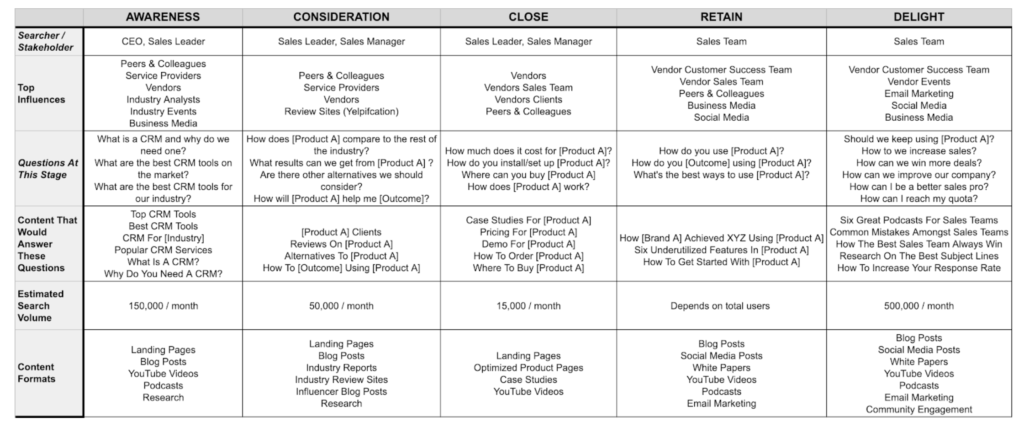
The B2B Buyer Journey Map lists the searcher, their top influences, the questions they have, the keywords they search, the estimated volume for these phrases, and the types of content that could be developed to match—for each stage in the buying process.
Download Excel Spreadsheet Here
Now in the sample map above, what’s the first content format listed for the first three stages?
Landing pages.
So once you’ve developed this B2B Buyer Journey Map, you can create landing pages that your audience will find valuable using platforms like Unbounce or other fantastic builders. At the awareness stage, for example, your landing page should target a broad range of keywords. You do this because you want to attract the largest audience possible to your content with the intent of converting them in the future. Some content that might do well at the awareness stage are phrases that are more specific to the thing you’re selling and the audience that wants it. For a CRM tool, this might be phrases like:
CRM for SMBs, CRM for Startups, CRM for Inbound Sales, CRM for Real Estate, etc.
And to capture this audience you might develop a landing page like this one from Pipedrive:
Disclaimer: Brands mentioned in this post are not clients or prospective clients at the time of publishing.
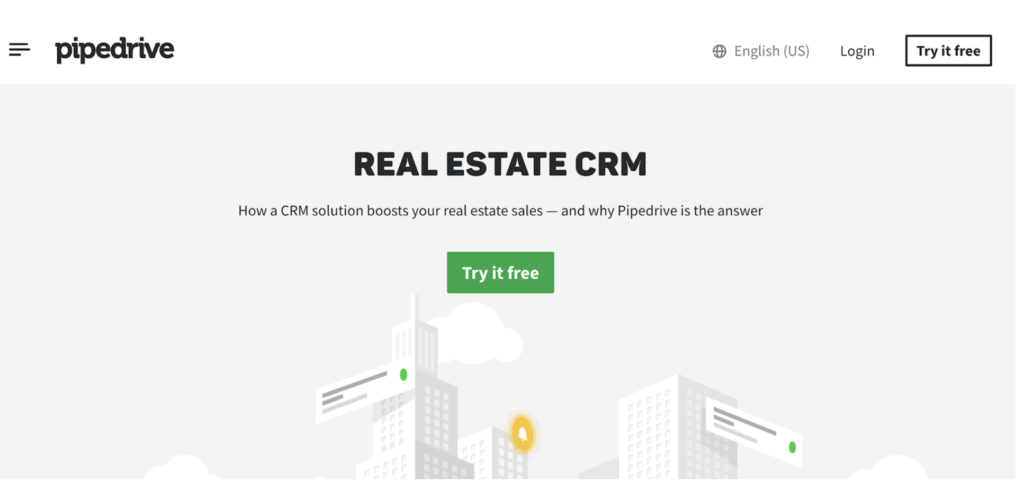
Or maybe you’re tackling prospects further down in the “consideration” phase. Potential buyers in this phase are typically looking to compare your product with others on the market.
In this case, your landing page might serve to compare your product to a competitor’s, like this page from Drift that takes a shot at their competitor Intercom:
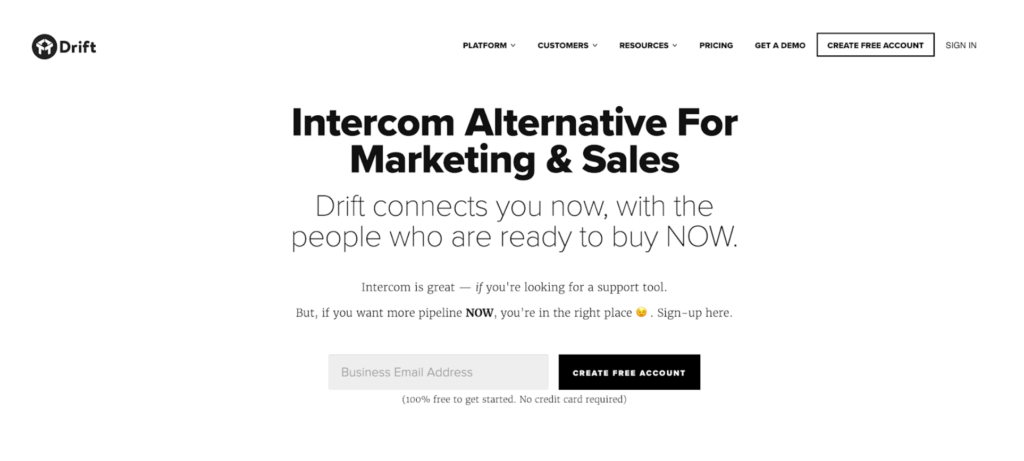
“Intercom is great — if you’re looking for a support tool. But, if you want more pipeline NOW, you’re in the right place.” OHHHH—THE SHADE IS REAL.
But don’t worry.
Intercom shot right back:
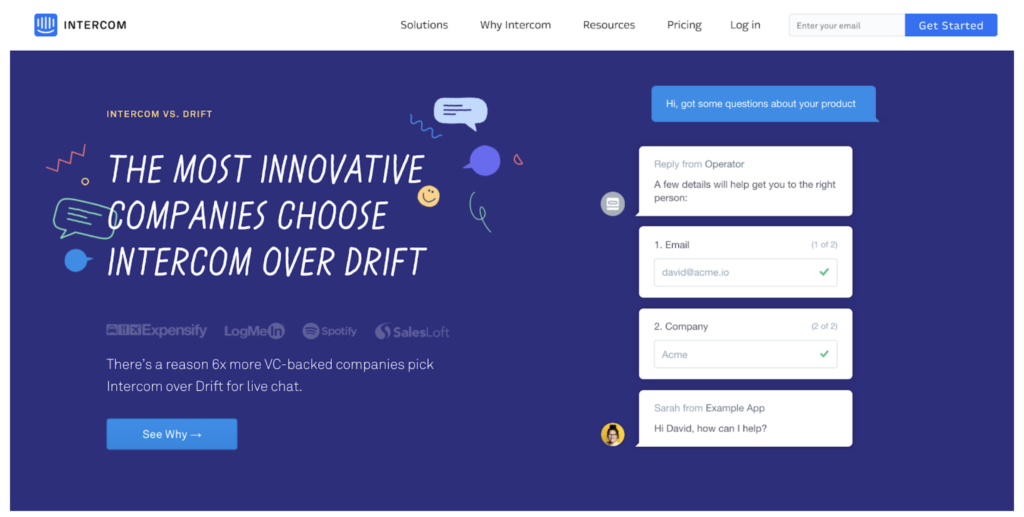
If you’re on the fence about investing in landing pages like these, install my favorite Chrome extension —Keywords Everywhere and search for “[Competitor] alternatives.”
Like this:

1,300 people a month are looking for Hubspot alternatives.
That’s massive!
If there’s even a little bit of volume there, you can rest assured that there are potential buyers you have an opportunity to reach.
At every step of the B2B Buyer Journey Map, there are opportunities to create content that could facilitate a sale—IF you take the time to research, understand and quantify those opportunities. You’re likely to uncover a few that your competitors are overlooking.
Keep Your Content Up-To-Date
Remember those 1,300 people looking for “Hubspot alternatives”?
The first thing they’re going to see on a SERP is a bunch of ads:
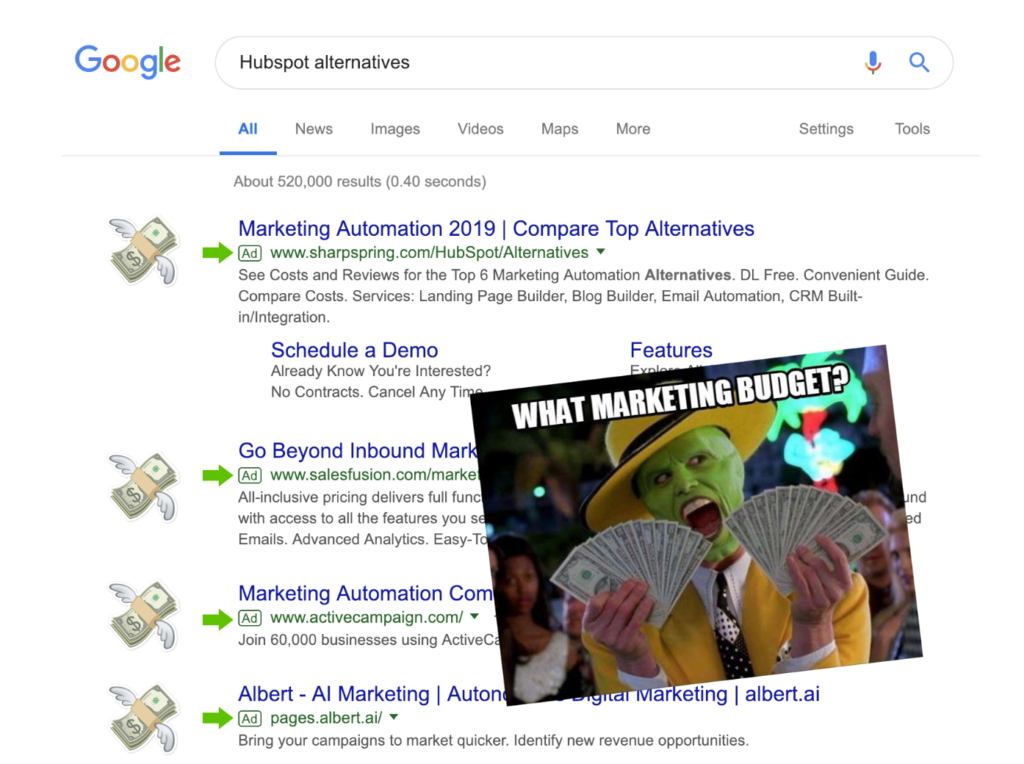
But after they scroll through this sea of expensive clicks they’ll find a post that is optimized for right now (that is when I’m writing this article):

Notice the [Early 2019] at the beginning?
Notice the “Nov 22, 2018” directly under the URL?
What’s happening here is quite smart.
Over the last few years, the update-and-republish approach has been a tried and true method of increasing search traffic to your content. The idea is simple:
Update the titles of old blog posts to include the current year. This strategy has two benefits:
(1) Increasing the click-through rate from users
(2) Improving your search engine ranking, resulting in your post moving up the SERP.
Google values recency and relevancy.
If the date on your blog post about must-own resources for sales professionals is 2012, the reader (and Google) is going to assume that the content may be outdated. That’s why it’s important to revisit these assets, update them with recent insights, and clearly state when the post was updated in the title—like this:
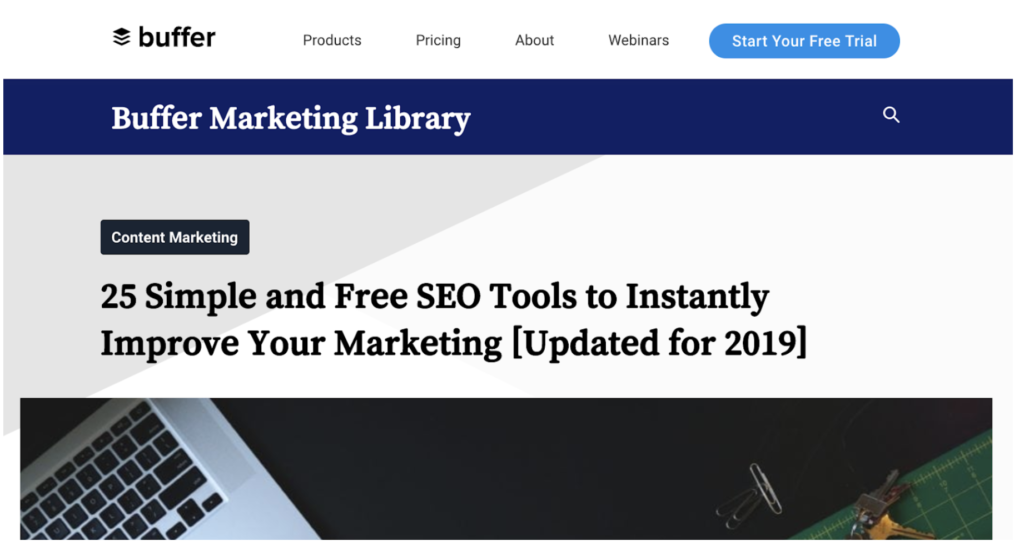
…or in the body copy with a simple line like:
This was originally published in 2018 and was last updated on January 19, 2020.
Create A Glossary Or Definition-Centric Landing Pages
People use Google like a dictionary, so providing definitions—whether for an acronym associated with your business like CRM, API, B2B, ERP or MAP, or some obscure corporate lingo you might hear at a conference—creates another touchpoint for individuals to visit your site and connect with your company. Plus, the people searching for these terms are more likely to be interested in the product or service you offer. Giving them the definition they’re looking for adds value while improving your search ranking.
Implementing the Keyword Glossary strategy requires a lot of writing as well as understanding what phrases your customers will be searching for. One of the originators of this strategy was Investopedia, who published a glossary of investment phrases.
Launched back in 1999, Investopedia has become one of the world’s most visited finance sites. Its success is due in large part to a vast collection of definitions related to accounting and finance:
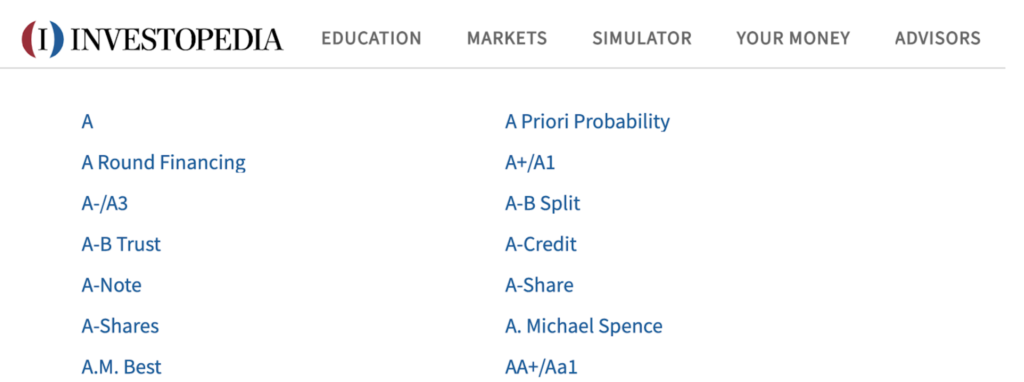
Investopedia’s definition page for “Return on Investment (ROI)” has more than 10,000 backlinks, “Exchange-Traded Fund (ETF)” has more than 8,000 backlinks, and the more recent phrase “Initial Coin Offering (ICO)” has more than 5,000 backlinks. It’s estimated that the definition pages on Investopedia attract more than 15 million visitors each month.
Another site that implemented the Keyword Glossary strategy is the SEO software company Moz. In the site’s SEO Learning Center, you can find phrases that are popular in SEO circles. For example, there’s a section dedicated to on-site SEO with questions like “What are domains?”

But it’s not just Moz + Investopedia.
The multibillion-dollar sales software company Salesforce leverages the Keyword Glossary strategy in its Learning Centre, where customers can find answers to questions like “What is CRM?” and “What is cloud computing?”

The Keyword Glossary strategy has proven greatly successful for Salesforce—a quick look at their top pages based on traffic and value shows us that those definition pages represent a significant portion of the site’s value:

Still not sold on this idea?
The folks at Credo are also using this strategy and finding great success. They’ve created definitions answering the question: What is Online Marketing and many more.
To take it a step further… They even have an SEO Dictionary filled with descriptions and definitions surrounding things like “XML Sitemaps” “Pagination” and “PageRank”:
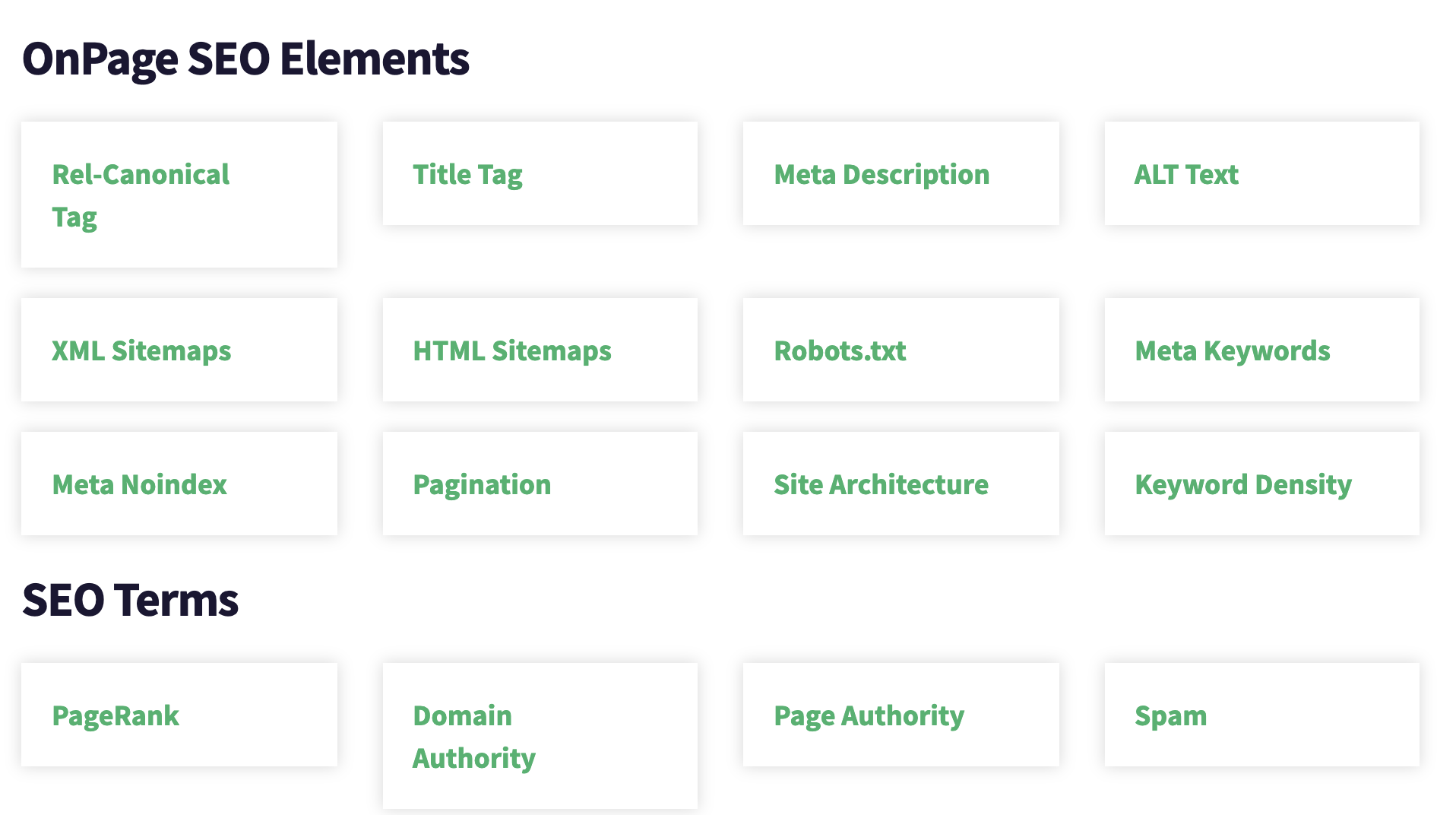
Brilliant right?
As you think about your own industry, consider how a glossary could help your customers. Do you sell a product in a relatively new market like esports or cryptocurrency? If so, there are plenty of new words and phrases that could make up your glossary. Is your industry full of jargon and industry-speak that most customers wouldn’t understand, like IT? If so, there’s an opportunity to give clarity to people looking for answers through an IT glossary.
Once you’ve created these definition pages on your site, be sure to link back to them in your own content. There’s no need to link out to Wikipedia or Dictionary.com in your blog posts—instead, you can build a network of internal links by referencing your own definition landing pages.
Conduct Keyword Research Using ACTUAL Google
It always fascinates me when I meet a marketer who spends the majority of their time using fancy search tools and little to no time using the actual search engine.
Relying on data from those other services is fine, but you can uncover a lot more by going directly to the source. Visit Google and type in phrases that your buyers would likely type:

The suggested search terms can give you insight into how people are using search.
Earlier I mentioned one of my favorite extensions, Keywords Everywhere. If you use that extension, you’ll see search volume and ad cost for each suggested keyword. This is valuable information—but even more valuable are the results you get when you press “Enter.”
Why?
Because you can do some reverse engineering to figure out why those results are ranking and what you can do to emulate their success. You can also use the SERP to see which review sites, influencers, and directories you need to engage.
Let’s take a closer look at the SERP for “best CRM”:

Of the links that appear in the SERP, just ONE is a sales page for this keyword.
The rest are blog posts from sites that don’t actually have a CRM, and one directory of software companies. This presents a two-fold opportunity for a CRM company: They could reach out to those sites to be featured in their lists or included in the directory, but they could also analyze the sales page and improve on its success.
NOTE: If you’re successful in landing a spot in high-ranking blog posts or directories, that’s a huge SEO win. Getting links from those sites could influence your ranking AND give you referral traffic from the blog posts.
Optimize Your Titles & H1s/H2s With Relevant Language
When you analyze successful sales landing pages for competitive phrases, you’ll notice that they have H1s and H2s that include keywords. It’s something that most SEO companies understand well.
But matching their success requires more than just adding H1 wrappers around search keywords.
It requires coming up with questions that are relevant to the target keywords found in your content. For example, a landing page about CRM software might include questions like: What should you look for in a CRM? and What industries are more likely to use our service? The answers to these questions could be filled with phrases and keywords that further illustrate to Google what this content is all about. In the industry, we call these relevant phrases “LSI keywords,” and using them in your landing pages offers an extra layer of context to the robots who determine how your page ranks.
LSI keywords are semantically related to the primary keyword you’re trying to rank for. For example, if someone Googles the word “focus,” how does Google determine what they’re trying to find?
An article titled “How To Focus More On Your Career In 2019” is very different than “Six Reasons Why A Ford Focus Is The Best Hatchback For The Money”—even though both contain the word “focus.” Here’s an example of the LSI keywords that each of these articles would have and the phrases Google would look to identify:

Google looks for LSI keywords to provide more context. A landing page about “Focus” containing words like “profession,” “job market” or “manager” clearly has a different context than a page with words like “vehicles,” “great steering,” “cars,” etc.
This is a good thing. It means you don’t have to worry about stuffing your pages with keywords like it’s 1999. Because at the end of the day…
It just doesn’t work.
Google now uses much more advanced algorithms that look for context.
Keywords matter, but keywords aren’t everything.
So how do you use LSI keywords on a landing page? Let’s use the keyword “best CRM” as an example again. Not only should you use the phrase “Best CRM” in an H1 like this…

…you should also explain the value proposition of a CRM system using LSI keywords, like sales forecasting, quota attainment, sales funnel, pipeline and sales strategies as seen here:

This is valuable content for both the reader and the search engine.
With this approach, you can inject even more LSI keywords and increase your likelihood of showing up in the SERP. It’s a win-win.
To quickly check all Titles and H1s/H2s, you can use Website SEO Checker by Sitechecker.
Keep URLs Short & Keyword-Rich
No one likes an ugly URL.
You hate to share it on X (formerly known as Twitter). You hate to copy it from your browser. And you hate looking at the random string of characters cluttering up your address bar.
You’re not alone.
Search engines don’t like ugly URLs either. In fact, a domain that doesn’t include any of your keywords is missing out. Why?
Because keywords (or lack thereof) in the domain still influences how well a page ranks in Google search results. It’s not the most important factor when it comes to search rankings, but it’s an easy one to implement—so why wouldn’t you?
Here are a few best practices to follow when creating your domain:

Good domains use a common language to describe what they’re all about. Decent domains combine common language with some not-so-pretty items that are required because of how the site was built. You should strive for cleaner URLs, but a few keywords in the domain are better than none. A horrible domain has no common language at all and a bunch of characters strung together that don’t offer any value to search engines.
Include Insightful Descriptions On B2B Ecommerce Product Pages
One thing that a lot of B2B brands overlook when creating product pages is the importance of having content on those pages. It’s popular on B2C sites, but B2B brands like to skimp on this effort to save time or money.
There are two reasons why B2B ecommerce sites should have content on their product pages:
- User Experience: A little bit of content can go a long way. If a prospective customer is torn between you and a competitor, little things like who provided the most information could be the deciding factor. The content on a product page can also help your buyers decide whether that particular product fits their needs and arm them with info to sell to others in their organization.
- Search Engine Optimization: The best ecommerce sites for B2B recognize that this content offers value not only to users but also to the crawlers that determine when a page is worth ranking.
Once these product and category pages are developed, look for opportunities to link back to them. Some of these links could be internal but some could be on third-party sites.
Which brings me to my next point…
Create Blog Posts & Link To Relevant Landing Pages
The reason we create landing pages is not for them to exist in a vacuum.
We create landing pages so we can link back to them often (on our own site and on others) and show Google how valuable these assets are. We create landing pages so we can attract the right people to our solutions, explain how we can help and give potential customers the info they need to make the best decision for their business.
One way you can make it more likely that your landing pages show up in search results is to create blog posts that link back to your landing pages, using your keywords as anchor text. Do this in blog posts that live on your own site as well as other sites.
If you have a landing page titled “The Best CRM For Small Businesses,” then a blog post titled “Six Reasons Why Every Small Business Needs A CRM” will give you plenty of opportunities to strategically link back to your own content.
Don’t get me wrong:
This strategy isn’t a silver bullet.
But it does offer you the chance to send link equity from other pages and websites to your own high-priority landing pages. As you build more and more high-quality links, the landing pages you link to will be viewed as more trusted and will be more likely to rank in search results.
Develop Lists Of Resources Your Buyers Would Want
One of my SEO crushes … er, marketing crushes … umm, affiliate crushes … OK—all-around website, business, and marketing crushes is Wirecutter.
The same way Investopedia is an SEO legend when it comes to the Glossary Strategy, the folks at Wirecutter are SEO legends when it comes to the List & Review (L&R) Strategy.
The strategy is straightforward, even simple. But it’s definitely not easy to do.
The List & Review Strategy is just this: Create a list of products your audience wants and review them.
Whether it’s headphones…

…or furniture…

…Wirecutter reviews anything and everything.
But what differentiates Wirecutter from most review sites is that their reviews are well-researched, are filled with insights and often incorporate expert perspectives.
The page “The Best Home-Office Furniture and Supplies” has more than 8,000 total words.
EIGHT THOUSAND!
And every single word counts.
To implement the List & Review Strategy as a B2B brand, you need to create landing pages or blog posts containing lists of products or solutions that their audience would be interested in. You can even incorporate your own products in the list that you’ve created.
Another company that has implemented this strategy extremely well is Zapier. You’ll find tons of blog posts on Zapier’s site that list the best apps and software products:

Each of these pages provides value to people who are interested in email apps, meeting scheduler apps, to-do list apps, etc. Combined, these pages are generating more than 200,000 visits per month to the Zapier blog.
The List & Review blog posts from Zapier typically consist of 10 products, with pricing, features, detailed descriptions, quality images, and links for each. This level of detail differentiates their approach to L&R and offers a lesson to you:
You need to make the list valuable. You need to give people enough information within the list that they feel like they can make an informed purchasing decision. You need to create a list that is ACTUALLY worth linking back to.
Because a great List & Review post gets links.
So What Do You Do Next?
It’s simple, really.
Get a cup of coffee…
…or tea…
…or whatever you prefer.
OK, great.
Now think about which of these ideas makes the most sense for your business, roll up your sleeves, and start doing whatever you need to do to get it done.
Did you find one idea in particular that stands out for your business?
Comment right now and let me know which one you plan to execute.








